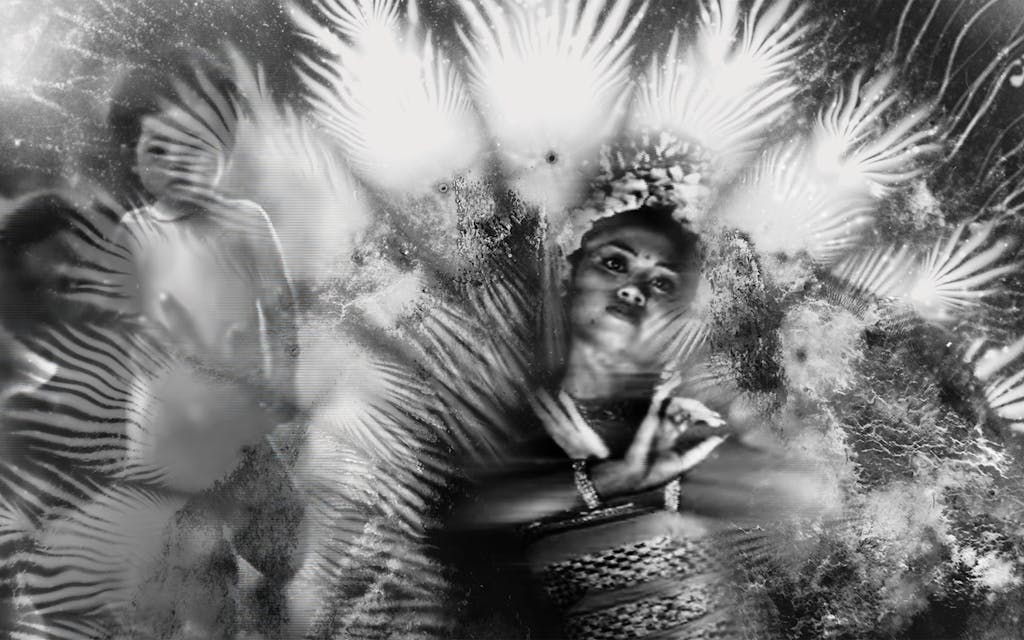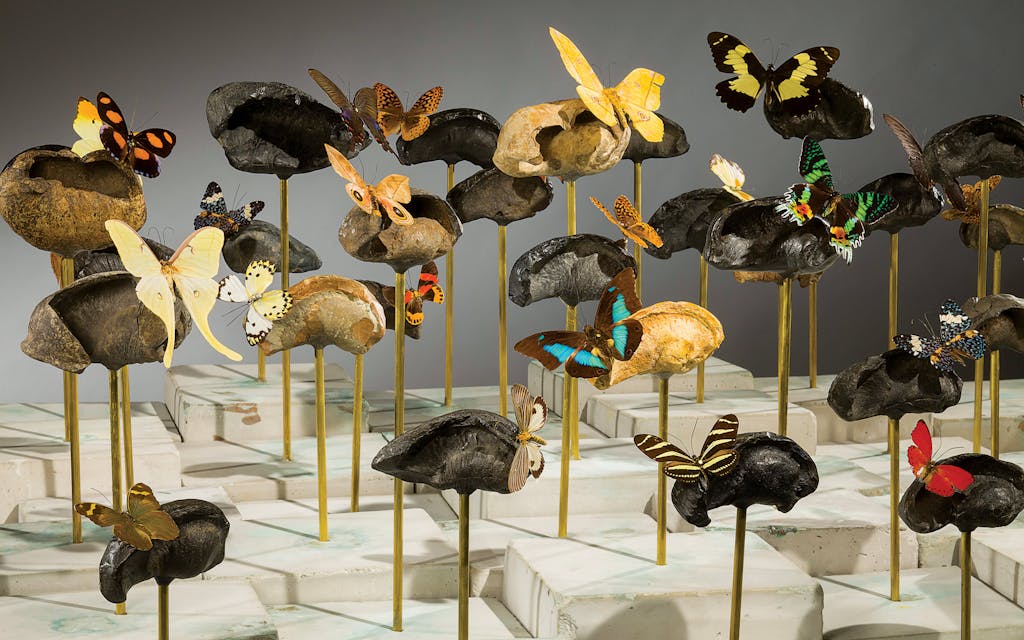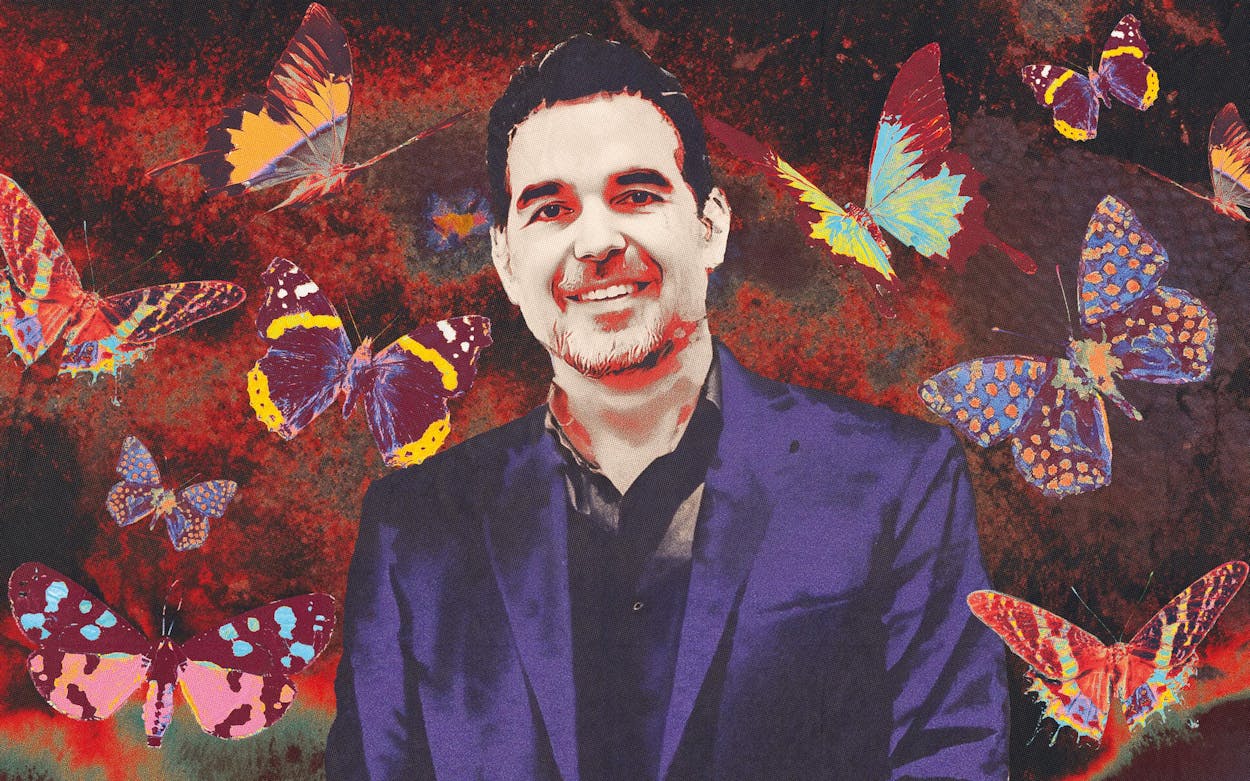Sprawled across the shag carpet in his San Antonio living room in 1979, six-year-old Dario Robleto was convinced that extraterrestrials had made contact with humankind. Robleto, home with a mild fever and possessed of an active imagination, mixed up something he saw on a news broadcast concerning the Golden Record, a time capsule–like phonograph album that had been launched into space four years earlier by NASA’s Voyager program.
The newscasters announced an 800 number that viewers could call to listen to the record’s audio track, which was full of sounds—ranging from a Bach concerto to surf pounding the sand—for an extraterrestrial civilization to someday decipher. “I thought they were announcing that we had made contact with aliens, and this was the record they were sending to us,” Robleto says. “I was overjoyed.”
When his bewildered single mother finally got home from work and, at his insistence, dialed the number for him, the Golden Record audio track was at its most inscrutable point, playing EKG and EEG recordings of a human heart and brain waves. These staticky thrumming sounds made little sense to a kid who’d spent half the day thrilled by the knowledge that we were no longer alone in the universe.

“I was so confused why they would send static,” says Robleto, who is now a celebrated multimedia artist. “It just crushed me.” His solo exhibition “The Signal,” which opens May 12 at Fort Worth’s Amon Carter Museum of American Art, is a way for him to finally reckon with that pivotal childhood experience.
The Golden Record (there are two identical copies, on different deep-space probes, both now more than 12 billion miles from Earth) is at the heart of the Carter show. There, Robleto, who is 51, will debut Ancient Beacons Long for Notice, the final film in a trilogy inspired by the NASA project, alongside a selection of related sculptures and prints. Houstonians who attend the exhibit may recognize themes that first appeared at Robleto’s 2014 Menil Collection exhibition, which explored the early history of cardiology and the Golden Record’s EEGs and EKGs.
That show was covered by the New York Times—in the Science section, not Arts & Leisure. It can be hard to say where Robleto belongs more. On the one hand, he’s every inch the artist, bubbling over with guileless wonder and waxing poetic on topic after topic. (He’s particularly articulate when discussing why the eighties British band the Smiths is revered by so many Latino kids from San Antonio, including him.) Yet he approaches art with the seriousness of purpose and empirical attitude of a research scientist.
José Luis Contreras-Vidal, the director of the Building Reliable Advances and Innovations in Neurotechnology Center at the University of Houston, first met Robleto a decade ago when the artist came to his office to ask if he thought we’d ever be able to use an EEG to detect when someone had fallen in love. The pair hit it off, talking for two hours. Soon they decided to partner on an unrelated experiment, measuring the electrical activity in the brains of audience members at Robleto’s Menil exhibition to see how viewing art affects brain activity.
“He was knowledgeable,” Contreras-Vidal says. “He was not only an artist. In my mind, he was also a researcher.”
In fact, Robleto initially majored in biology at the University of Texas at San Antonio, with no intention of pursuing an art career. But he says his artistic values stretch back to a childhood spent tagging along with his mother to her two jobs, as a hospice nurse and as a honky-tonk waitress. At the hospice, he absorbed the philosophy that the last second of life is just as important as the first. Her bar gig made an equally deep impression. “To hear Patsy Cline [on the jukebox] literally describing what I was seeing in front of me in real time was a mind-blowing experience of, ‘Oh, art is documentarian,’ ” he says. “That, merged with my experiences with the hospice nurses, really formed a particular attitude about art making.”

At 22, Robleto experienced what he calls an epiphany. He’d recently moved in with his father, who’d been absent most of his life. The arrangement went “horribly” and spiraled him into an immobilizing depression. One morning his father, a Nicaraguan immigrant who’d learned English by listening to the Beatles, departed for work and unintentionally left his Sgt. Pepper’s Lonely Hearts Club Band CD playing on repeat in the living room.
“I hadn’t come out of my room in days,” Robleto says. “But listening to Sgt. Pepper’s on repeat, muffled through that wall, for twelve hours, ignited me. I was finally ready to leave, and I left. And the first thing I did was go to an art store.” Robleto set himself a task that afternoon: to cover every square inch of his bedroom with drawings and not leave the room until he was done. It took him a few days.
After graduating with a bachelor of fine arts from UTSA, Robleto moved on to more-elusive art goals. He devised a set of “actions” to test what art could do even if its presence went undetected. For one such subtle intervention, he sneaked around his grandmother’s northeast San Antonio block, switching out every porch light with a slightly brighter bulb. For another, he brought a seashell from a Gulf Coast beach to the honky-tonk, Dave’s Place, where his mother worked. He held the shell against the jukebox while a Patsy Cline song played, then returned it to the beach.
The anonymity of these gestures was inspired by late-nineties DJ culture, a big part of Robleto’s life at the time. The San Antonio electronic-music scene of that era was small but passionate, and Robleto drew on it in his next body of work. “Basically, I said, ‘How does one take the skills of the DJ—the curatorial obsessiveness, the attention to sequencing, the physicality of turntablism—and bring them into the sculptural realm?’ ”
Sculptures based on such questions filled Robleto’s first real art shows, at venues such as the Blue Star Arts Complex, in San Antonio, and DiverseWorks, in Houston, where he is now based. For Untitled (Patsy’s Spool), Robleto made a spool of thread by thinly slicing, from the outer rim to the center, a 45-rpm vinyl copy of Cline’s “I Fall to Pieces.” For American Seabed, on view at the Carter, he attached fossilized whale ear bones to butterfly specimens whose antennae he replaced with audiotape of Bob Dylan’s “Desolation Row” that he’d stretched and pulled to a filament-like diameter.
Many of Robleto’s other sculptural works are composed of a similarly eye-popping array of materials. One piece purports to include a “million-year-old raindrop.” Another features trinitite-—glass formed from sand that was fused by the heat of the 1945 Trinity atomic bomb test in New Mexico.
Robleto is adamant that all of his claims about materials are accurate. “Lying is easy,” he says. “To really do it is the harder, more interesting path.” He calls materials lists, which appear next to artworks on the walls of most museums, an “unrecognized literary format” that he wants to approach like a poet. Indeed, he often writes a materials list before he knows what a sculpture will look like.
Over the past few years, Robleto has moved away from sculptures made of such esoteric materials. He’s given up his art studio altogether, along with his gallery representation, focusing his time instead on an art-film trilogy and a book coauthored with the Harvard art historian Jennifer Roberts (due next year from Simon & Schuster) centered on the Golden Record. He attributes the shift in practice to a radical self-evaluation during the pandemic.
Robleto describes his three recent films—The Boundary of Life Is Quietly Crossed, The Aorta of an Archivist, and now Ancient Beacons Long for Notice—as responses to the question, “What if an artist directed an episode of Cosmos?” He’s referring to Cosmos: A Personal Voyage, a PBS science miniseries that ran from 1980 to 1981 and was watched by more than 500 million worldwide. The show was hosted by the astronomer Carl Sagan, who, along with a team of five at NASA, was responsible for selecting the contents on the Golden Record. Robleto’s approach is more immersive and poetic than what Sagan could have gotten away with on public television, with leaps of imagination and an eccentric visual style rooted in nineteenth-century technology.
In Ancient Beacons, Robleto delves into the story of the Golden Record’s creation, focusing on Sagan’s collaborator and, later, wife, Ann Druyan. Robleto makes a case for Druyan, the Golden Record’s creative director, as “our greatest avant-garde, feminist conceptual artist that nobody’s accounted for.” Druyan was an advocate for some of the more boundary-nudging aspects of the Golden Record. For instance, she pushed to include “Johnny B. Goode” alongside the selections of classical and world music. (A choice that led to a famous Steve Martin bit as a psychic on Saturday Night Live, in which he relays the aliens’ reply to the record: “Send more Chuck Berry.”)
In fact, Druyan was even more subversive than that. It was her heartbeats and brain waves that were recorded for the Golden Record—the very sounds that so disappointed the young Robleto on that formative sick day in 1979. When Robleto befriended her about fifteen years ago, they discussed how NASA had decreed that the Golden Record couldn’t include anything that portrayed humanity in a negative light. Druyan also confessed to him how, inspired by an audio recording of a World War I battle, she’d felt compelled to stow away an honest appraisal of our darker nature. Sitting for her EEG, Robleto says, “She thought about Vietnam. She thought about environmental devastation. She thought about poverty, racism, and misogyny. She thought about nuclear weapons.” (Having fallen for Sagan a few days earlier, she also thought about love.)
“She asked what I think was the most morally important question,” Robleto says. “Which is: If this is the final document of your planet, and you’re pressed in a position to speak for everyone forever, do you not have a responsibility for a full accounting of what we were?” Druyan’s subversion of NASA’s edict was a heady mix of ethical commitment and impossible hope—there’s a one-in-a-million chance that anyone on the other end will ever listen to her EEG signals, set off against another one-in-a-million chance that anyone will ever be able to decipher them.
Still, someone, at least, has been paying attention. Robleto, who has been puzzling out Druyan’s cryptic message for more than four decades, has made evocative sense from what was once so frustratingly insensible, resolving a cosmic disenchantment he first experienced when he was six years old.
“It’s hard for me, after all these years, to understand that I found an answer,” he says. “It took forty years, but I did it.”
It’s a small miracle, and a tribute to his refusal to give in to cynicism or nihilism, just how meaningful those staticky thrumming noises on the phone have turned out to be.
This article originally appeared in the May 2024 issue of Texas Monthly with the headline “Dario Robleto’ s Cosmic Transmissions.” Subscribe today.
- More About:
- Art







